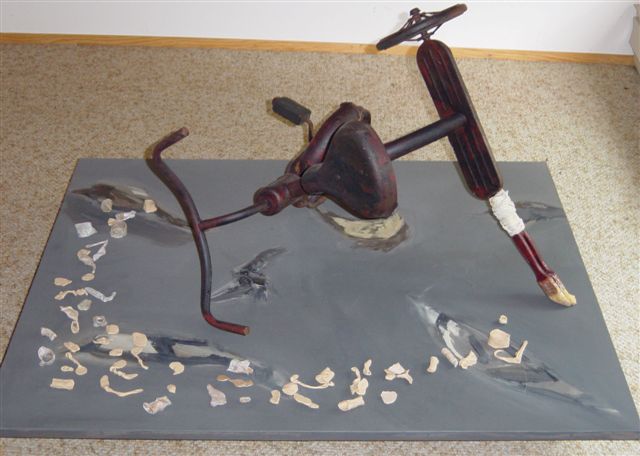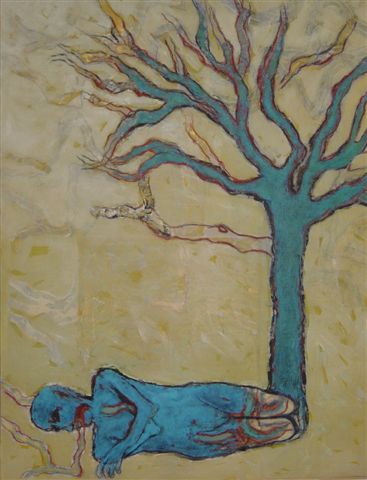CHRISTINA COLEMAN'S

ART IMPERATIVE
by Lydia Schrufer
Christina
Coleman has been painting for most of her adult life. She has
exhibited in Canada and in Mexico. Her works are also found
in corporations and in several private collections.
* * * * * * * * * *
What makes someone
choose a career that, for the most part, offers so little financial
reward or public understanding? I asked that question of artist
Christina Coleman in her studio where paint spattered floor
and stacks of paper and canvas exude a palpable feeling of activity
and energy. I felt she had just put down the brushes and would
take them up again as soon as I left.

Silence
Coleman’s
passion for art and dance dates to her earliest memories. They
provided the opportunity to escape her middle class Irish immigrant
background to the more graceful cultural life she imagined for
herself. As a young ballerina, she traveled throughout the world,
living and working in many different countries. But even then
she painted, embracing it as a form of meditation that allowed
her to transcend ego preoccupations and the entanglements of
the everyday world. Both disciplines have enabled her to achieve
the perfection for which she is known. From her thrifty Irish
roots, Christine learned to be creative with the most limited
of materials, often working in tiny, draughty spaces. She has
painted in both happy times and in devastatingly difficult times.
Most recently, during the long illness and loss of her beloved
friend
and husband, it was her art that sustained her spirit and sanity.
And while she admits to being a worrier and too empathetic for
her own good, in the studio she is calm and in control.

Portrait
Blue
Today,
Cristina Coleman’s posture and bearing betray her extensive
international dance experience, and her slim, agile body makes
one doubt her seventy years. Her enthusiasm and contagious interest
in every aspect of what’s new and happening in the art
world is what makes her work fresh and daring. The edgy, contemporary
art she produces is testimony to the unwavering discipline she
demands of herself. Christina believes that if the work doesn’t
come from the gut it isn’t worth doing -- and even less
worth looking at.

Accident
of Birth
Christina
is surrounded by nature, which is a continued source of inspiration.
Organic elements such as branches, roots and plants are often
integrated into her works. Evidence of her affinity for nature
is everywhere in her studio and in her home: fragile birds’
nests artfully arranged on the window ledge, tortured branches
that make a statement in a far corner, an arching frond of lacy
grass placed in a simple vase at the base of which are laid
beautiful rounded stones collected from a walk in the fields.
There can be no doubt that these arrangements, in the sure hands
of the artist, rise to the occasion of art where the fragility
of the human condition and natural world are the recurring leitmotifs
in her paintings, drawings and installations.

Looking
Christina’s
preferred medium is thick, black charcoal, which she sometimes
wields like a delicate carving tool and which explains why her
early work was more graphic than painterly. The images, primarily
stylized figures in non specific environments, are rendered
in distinctive, sensuous lines that seem carved into the surface.
They occupy and energize the whole painting or drawing and are
always positioned in just ‘the’ right place for
maximum visual tension. She explains that her acutley developed
awareness and instinctive ability to manipulate the elements
and figures in her art were honed as a dancer where she would
always be conscious of her physical position in relationship
to other bodies and the many stages on which she performed.

Dearth
If
the artist’s early work was often monochromatic and earth
toned, her later work is comprised of more painterly celebrations
of color. Neverthless, a strong graphic element remains and
her line still vibrates. Never satisfied or repetitive, Christina
constantly explores and experiments with mediums, format and
materials, and especially new ideas she yearns to convert into
concrete visual realties. She is incurably curious and gutsy,
and like an art explorer, loves to push the boundaries. Over
the years, she has worked in many different materials, from
printmaking to sculpture. What she regrets most is never having
enough time or resources to realize all her projects. She would
love to try her hand at huge installations. “Wouldn’t
it be fabulous if one could work on the scale of, say, Louise
Bourgeois or Joe Fafard or Richard Serra?” No matter what
medium Christina uses to convey her ideas and emotions, her
work elicits parallel feelings of sorrow and joy in her viewers,
and corroborates her long-held belief in Jung’s theory
of the collective unconscious. Minimalist artist Agnes Martin
(1912-2004) insists that, “communication is what art is
all about. Trying to bridge the gap between the maker and the
viewer,” a view which Christina supports and to which
she adds: "for the work to be complete and exist on its
own merit, it has to be seen by others.”

Yet
I Am Not a Tree
When
I asked Christina what artists she admires and have influenced
her, she laughed, replying, “they’re always changing
because I never tire of looking at art, but I have a special
affinity for Giacometti (1901-1966) and Francis Bacon (1909-1992).
Francis Bacon broke the rules and changed what’s possible
and Giacometti’s line and the environment he creates around
his figures are so beautiful. I appreciate any artist who takes
risks. No matter what technical advances occur, the human hand
can never be replaced. What the hand creates is an endless surprising
revelation.”


Clothing
Series
Christina’s
studio is an annex of her home where her art and living space
are a seamless, creative ambience -- a celebration of elegant,
imaginative living. Mixed into her living quarters are carefully
chosen ‘objects’ placed here and there, as well
as original paintings and drawings on her large, white walls
which, for the occasion of my visit, were bathed in an abundance
of natural light streaming in through floor-to-ceiling windows.
Make no mistake about it, Christina Coleman lives in her art.
Christina
continues to evolve as an artist because she isn't afraid to
admit and learn from her mistakes. She’s her own toughest
critic and well aware of the dangers of spending too much time
in the comfort zone. “Failure has informed me as much
as success,” she insists. “And every now and then
you get it just right.” And to my original question at
the top of this piece, she answered: “Art is my way of
being. It’s as much part of me as breathing in and out.”
The
poet Rainer Marie Rilke once said, “If you think you are
capable of living without writing, do not write.” Perhaps
that is why people choose a career in the arts; they just cannot
live without creating.
For
more information on the artist, please contact Arts Editor
Lydia
Schrufer.